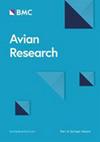From fledging to independence: Post-fledging movements and space use of the Crested Ibis (Nipponia nippon)
IF 1.7
2区 生物学
Q1 ORNITHOLOGY
引用次数: 0
Abstract
The post-fledging period, extending from fledging to independence, is a crucial life stage characterized by high mortality due to fledglings' limited mobility and inexperience. During this stage, fledglings gradually increase their mobility, leave their parents, disperse from their natal site, and respond to the challenges of new environments. Characterizing these post-fledging movements and space use is essential for understanding juvenile survival strategies and devising targeted conservation measures. The Crested Ibis (Nipponia nippon), an endangered species and a highly protected animals at the national level in China, has seen limited research on its post-fledging movements and space use. From 2015 to 2023, we utilized biologgers, combined with field surveys, to study the movement and space use characteristics of 37 fledglings in Hanzhong City, Shaanxi Province, China, over a two-month post-fledging period. We quantified changes in activity levels (based on overall dynamic body acceleration), independence timing, onset of post-fledging dispersal, habitat selection, and daily activity rhythms after independence. Our results revealed individuals began independent living 26.23 ± 2.34 days post-fledging and onset of dispersal at 25.58 ± 2.33 days, with a range area at the natal of 2.08 ± 0.56 km2. The initial 30 days post-fledging are characterized as an ontogenetic phase marked by a rapid increase in body activity level. Fledglings preferred paddy fields during the independent period rather than the forests they relied on before independence. Interestingly, the daily activity rhythm, particularly foraging behavior, peaked at noon—contrasting with the expected morning and evening activity peaks—likely as an adaptation to avoid periods of peak human activity. Additionally, drowning, collisions, and predation in paddy fields are noteworthy causes of fledgling mortality. Consequently, we recommend protecting a 2-km2 area around the nest site for at least two-month post-fledging, implementing safety measures around power lines and cesspools. Additionally, reducing human disturbances near foraging habitats and expanding space within paddy fields would help mitigate survival pressures on fledglings.
从羽化到独立:朱鹮羽化后的运动和空间利用
羽化后阶段,即从羽化到独立,是雏鸟生命的关键阶段,其特点是由于雏鸟的活动能力有限和缺乏经验,死亡率高。在这一阶段,雏鸟逐渐增加流动性,离开父母,离开出生地,并对新环境的挑战做出反应。表征这些羽翼后的运动和空间利用对于了解幼鸟的生存策略和制定有针对性的保护措施至关重要。朱鹮(Nipponia nippon)是一种濒危物种,是中国国家级高度保护动物,对其羽化后的活动和空间利用的研究有限。2015 - 2023年,我们利用生物学家的方法,结合野外调查,对陕西省汉中市37只雏鸟羽化后2个月的活动和空间利用特征进行了研究。我们量化了活动水平的变化(基于整体动态身体加速度)、独立时间、羽化后扩散的开始、栖息地选择和独立后的日常活动节奏。结果表明,个体在羽化后26.23±2.34天开始独立生活,在25.58±2.33天开始分散,出生时的活动范围为2.08±0.56 km2。初生30天的特点是个体发育阶段,身体活动水平迅速增加。独立时期的雏鸟更喜欢水田,而不是独立前他们所依赖的森林。有趣的是,日常活动节奏,特别是觅食行为,在中午达到高峰,与预期的早晨和晚上活动高峰形成对比,可能是为了避免人类活动高峰时期的适应。此外,水田中的溺水、碰撞和捕食是雏鸟死亡的重要原因。因此,我们建议在雏鸟羽化后至少两个月保护鸟巢周围2平方公里的区域,并在电线和污水池周围实施安全措施。此外,减少觅食栖息地附近的人为干扰和扩大稻田内的空间将有助于减轻雏鸟的生存压力。
本文章由计算机程序翻译,如有差异,请以英文原文为准。
求助全文
约1分钟内获得全文
求助全文
来源期刊

Avian Research
ORNITHOLOGY-
CiteScore
2.90
自引率
16.70%
发文量
456
审稿时长
46 days
期刊介绍:
Avian Research is an open access, peer-reviewed journal publishing high quality research and review articles on all aspects of ornithology from all over the world. It aims to report the latest and most significant progress in ornithology and to encourage exchange of ideas among international ornithologists. As an open access journal, Avian Research provides a unique opportunity to publish high quality contents that will be internationally accessible to any reader at no cost.
 求助内容:
求助内容: 应助结果提醒方式:
应助结果提醒方式:


